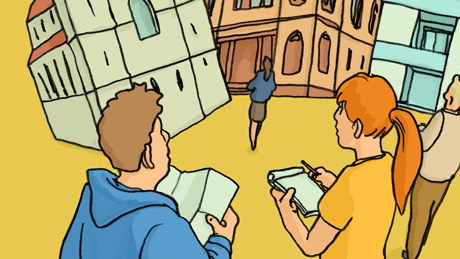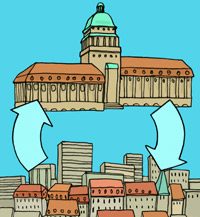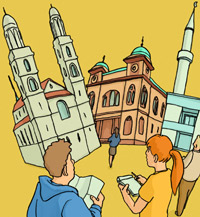Navigation auf uzh.ch
Navigation auf uzh.ch

“We want to encourage instructors to come up with new ideas in their teaching, and test, vary, and improve them in practice,” says UZH president Michael Hengartner. To this end, in 2016 UZH created the “Lehrkredit” Teaching Fund. Fifteen projects were approved in January of this year.
The four representatives described here show just how varied the approaches adopted by the teaching formats selected are. The first and second examples involve research-based learning, the third is all about a playful approach to rehearsing complex decisionmaking processes, and the fourth is designed to promote writing skills. What they all have in common is the principle of learning by doing.

1. Political Science
As Mephistopheles said to Faust, all theory is gray – but practical relevance can help make study more colorful. A so-called capstone course at the Department of Political Science builds a bridge between research and practice. The idea is for advanced students to work, as independently as possible, on research projects addressing questions raised by external clients – and deliver professional answers. In doing so they learn how to apply theoretical knowledge to practical cases. On behalf of the SDC (Swiss Agency for Development and Cooperation), for example, one group of students is developing a digital map of migration. It’s intended to show the composition of groups of refugees and the routes they choose. A particular challenge is how to handle heterogeneous data sets.
The Teaching Fund is enabling the Department of Political Science to gain experience with capstone courses, which are very complicated to plan and deliver. The format isn’t a new invention. The name is derived from a term in building: The capstone is the element placed at the highest point of an arch to stabilize it. Accordingly, a capstone course combines content from the entire study program. From designing the research through gathering and evaluating the data and presenting the findings, the students go through all the phases of the research cycle. They also get to train soft presentation, communication, organizational, and management skills.

2. Medicine
A patient lies unconscious in the hospital’s emergency room. This person is in urgent need of a blood transfusion to save their life. But since they’re a Jehovah’s Witness, you have to assume that they would refuse a transfusion on religious grounds. What can you do? With the help of a gamified e-tool currently being developed at the Institute of Biomedical Ethics and History of Medicine, budding physicians will soon be able to train the way they deal with ethical dilemmas. Part of the e-tool is a so-called serious moral game, an interactive set of ethically complex cases students have to resolve. The e-tool is to be made available online. It’s designed to augment rather than replace in-class learning in biomedical ethics. It will be implemented for the first time in the coming fall semester. The goal is to use it as standard in medical studies.

3. Study of Religions
The title tells you what it’s all about: “From research hypothesis to conference panel” is a teaching project designed to give insights into all the phases of a research project in history and religion. Students look at churches, synagogues, mosques, and temples in Zurich to analyze the communicative functions of the architecture of sacred buildings. The themes include the question of how a facade manifests a religion’s self-image vis-à-vis society, or what role the interior rooms play in the self-organization of a community. Most of the seminar is held outside the university, directly at the buildings being studied. This approach closely connects research, teaching, and learning.

4. Geography
Academic writing is something that has to be learned and practiced, but helping students develop their writing skills on an individual basis is time-consuming. Especially in large courses it’s virtually impossible for instructors to assess their students’ written work in detail. This is where calibrated peer reviews come in. The basic idea is that students rate each other’s written work on a structured basis.
First of all, instructors create sample “calibration” submissions with clearly defined assessment criteria. Then the students used these submissions as a basis for reviewing three pieces of written work submitted by their peers. After this they evaluate their own submission. The software facilitates the review process on the basis of the different evaluations, which can be calibrated differently according to accuracy and depth. Students alternate between the roles of author and critic to experience what academic writing involves. The instructor guides the whole process. Thanks to the Teaching Fund, UZH is for the first time able to try out the Calibrated Peer Review developed at the University of California.